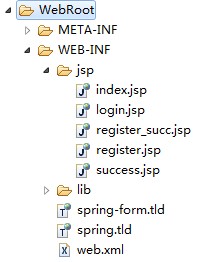SpringMVC +Spring+ SpringJDBC整合实例。文件结构:


3S3(3Spring3.x)的整合大致如下:
1)web.xml的配置:
|
1
2
3
4
5
6
7
8
9
10
11
12
13
14
15
16
17
18
19
20
21
22
23
24
25
26
27
28
29
30
31
32
33
34
35
36
|
<?xml version="1.0" encoding="UTF-8"?><web-app xmlns:xsi="http://www.w3.org/2001/XMLSchema-instance" xmlns="http://java.sun.com/xml/ns/javaee" xmlns:web="http://java.sun.com/xml/ns/javaee/web-app_2_5.xsd" xsi:schemaLocation="http://java.sun.com/xml/ns/javaee http://java.sun.com/xml/ns/javaee/web-app_3_0.xsd" version="3.0"> <display-name></display-name> <welcome-file-list> <welcome-file>index.jsp</welcome-file> </welcome-file-list> <listener> <listener-class>org.springframework.web.util.IntrospectorCleanupListener</listener-class> </listener> <servlet> <servlet-name>spring</servlet-name> <servlet-class>org.springframework.web.servlet.DispatcherServlet</servlet-class> <init-param> <param-name>contextConfigLocation</param-name> <param-value>classpath:*applicationContext.xml</param-value> </init-param> <load-on-startup>1</load-on-startup> </servlet> <servlet-mapping> <servlet-name>spring</servlet-name> <url-pattern>*.do</url-pattern> </servlet-mapping> <!-- 统一字符编码为UTF-8 --> <filter> <filter-name>setcharacter</filter-name> <filter-class>org.springframework.web.filter.CharacterEncodingFilter</filter-class> <init-param> <param-name>encoding</param-name> <param-value>utf-8</param-value> </init-param> </filter> <filter-mapping> <filter-name>setcharacter</filter-name> <url-pattern>/*</url-pattern> </filter-mapping></web-app> |
2)applicationContext.xml的配置:
|
1
2
3
4
5
6
7
8
9
10
11
12
13
14
15
16
17
18
19
20
21
22
23
24
25
26
27
28
29
30
31
32
33
34
35
36
37
38
39
40
41
42
43
44
45
46
47
48
49
50
51
52
53
54
55
56
57
58
59
60
61
62
63
64
65
66
67
68
69
70
71
72
73
74
75
76
77
78
79
80
81
82
83
84
85
86
87
88
89
90
91
92
93
94
95
96
97
98
99
100
101
102
103
104
105
106
107
108
109
110
111
112
113
114
115
|
<?xml version="1.0" encoding="UTF-8" ?><beans xmlns="http://www.springframework.org/schema/beans" xmlns:xsi="http://www.w3.org/2001/XMLSchema-instance" xmlns:p="http://www.springframework.org/schema/p" xmlns:context="http://www.springframework.org/schema/context" xmlns:aop="http://www.springframework.org/schema/aop" xmlns:tx="http://www.springframework.org/schema/tx" xsi:schemaLocation="http://www.springframework.org/schema/beans http://www.springframework.org/schema/beans/spring-beans-3.0.xsd http://www.springframework.org/schema/context http://www.springframework.org/schema/context/spring-context-3.0.xsd http://www.springframework.org/schema/tx http://www.springframework.org/schema/tx/spring-tx-3.0.xsd http://www.springframework.org/schema/aop http://www.springframework.org/schema/aop/spring-aop-3.0.xsd"> <context:property-placeholder location="classpath:jdbc.properties" /> <!-- 扫描类包,将标注Spring注解的类自动转化Bean,同时完成Bean的注入 --> <context:component-scan base-package="com.controller" /> <context:component-scan base-package="com.service" /> <context:component-scan base-package="com.dao" /> <!-- 配置数据源 --> <bean id="dataSource" class="com.mchange.v2.c3p0.ComboPooledDataSource" destroy-method="close"> <property name="driverClass"> <value>${jdbc.driverClassName}</value> </property> <property name="jdbcUrl"> <value>${jdbc.url}</value> </property> <property name="user"> <value>${jdbc.username}</value> </property> <property name="password"> <value>${jdbc.password}</value> </property> <!--连接池中保留的最小连接数。 --> <property name="minPoolSize"> <value>5</value> </property> <!--连接池中保留的最大连接数。Default: 15 --> <property name="maxPoolSize"> <value>30</value> </property> <!--初始化时获取的连接数,取值应在minPoolSize与maxPoolSize之间。Default: 3 --> <property name="initialPoolSize"> <value>10</value> </property> <!--最大空闲时间,60秒内未使用则连接被丢弃。若为0则永不丢弃。Default: 0 --> <property name="maxIdleTime"> <value>60</value> </property> <!--当连接池中的连接耗尽的时候c3p0一次同时获取的连接数。Default: 3 --> <property name="acquireIncrement"> <value>5</value> </property> <!--JDBC的标准参数,用以控制数据源内加载的PreparedStatements数量。但由于预缓存的statements 属于单个connection而不是整个连接池。所以设置这个参数需要考虑到多方面的因素。 如果maxStatements与maxStatementsPerConnection均为0,则缓存被关闭。Default: 0 --> <property name="maxStatements"> <value>0</value> </property> <!--每60秒检查所有连接池中的空闲连接。Default: 0 --> <property name="idleConnectionTestPeriod"> <value>60</value> </property> <!--定义在从数据库获取新连接失败后重复尝试的次数。Default: 30 --> <property name="acquireRetryAttempts"> <value>30</value> </property> <!--获取连接失败将会引起所有等待连接池来获取连接的线程抛出异常。但是数据源仍有效 保留,并在下次调用getConnection()的时候继续尝试获取连接。如果设为true,那么在尝试 获取连接失败后该数据源将申明已断开并永久关闭。Default: false --> <property name="breakAfterAcquireFailure"> <value>true</value> </property> <!--因性能消耗大请只在需要的时候使用它。如果设为true那么在每个connection提交的 时候都将校验其有效性。建议使用idleConnectionTestPeriod或automaticTestTable 等方法来提升连接测试的性能。Default: false --> <property name="testConnectionOnCheckout"> <value>false</value> </property> </bean> <!-- 配置Jdbc模板 --> <bean id="jdbcTemplate" class="org.springframework.jdbc.core.JdbcTemplate"> <property name="dataSource" ref="dataSource"></property> </bean> <!-- 配置事务管理器 --> <bean id="transactionManager" class="org.springframework.jdbc.datasource.DataSourceTransactionManager" p:dataSource-ref="dataSource" /> <!-- 通过AOP配置提供事务增强,让service包下所有Bean的所有方法拥有事务 --> <aop:config proxy-target-class="true"> <aop:pointcut id="serviceMethod" expression=" execution(* com.service..*(..))" /> <aop:advisor pointcut-ref="serviceMethod" advice-ref="txAdvice" /> </aop:config> <tx:advice id="txAdvice" transaction-manager="transactionManager"> <tx:attributes> <tx:method name="*" /> </tx:attributes> </tx:advice> <!-- 启动Spring MVC的注解功能,完成请求和注解POJO的映射 --> <bean class="org.springframework.web.servlet.mvc.annotation.AnnotationMethodHandlerAdapter" /> <!-- 配置视图解析器,将ModelAndView及字符串解析为具体的页面 --> <bean class="org.springframework.web.servlet.view.InternalResourceViewResolver" p:viewClass="org.springframework.web.servlet.view.JstlView" p:prefix="/WEB-INF/jsp/" p:suffix=".jsp" /></beans> |
3)jdbc.properties的配置:
|
1
2
3
4
|
jdbc.driverClassName=com.mysql.jdbc.Driverjdbc.url=jdbc:mysql://localhost:3306/test2jdbc.username=rootjdbc.password=123456 |
4)log4j.properties的配置:
|
1
2
3
4
5
|
log4j.rootLogger=DEBUG,A1# \u8f93\u51fa\u5230\u63a7\u5236\u53f0log4j.appender.A1=org.apache.log4j.ConsoleAppenderlog4j.appender.A1.layout=org.apache.log4j.PatternLayoutlog4j.appender.A1.layout.ConversionPattern=%d{yyyy-MM-dd HH\:mm\:ss} [\u65E5\u5FD7\u4FE1\u606F] %m%n |
5)User.java
|
1
2
3
4
5
6
7
8
9
10
11
12
13
14
15
16
17
18
19
20
21
22
23
24
25
26
27
28
29
30
31
32
|
package com.model;import java.io.Serializable;@SuppressWarnings("serial")public class User implements Serializable { private int id; private String userName; private String password; public String getUserName() { return userName; } public void setUserName(String userName) { this.userName = userName; } public String getPassword() { return password; } public void setPassword(String password) { this.password = password; } public int getId() { return id; } public void setId(int id) { this.id = id; } } |
6)UserController.java
|
1
2
3
4
5
6
7
8
9
10
11
12
13
14
15
16
17
18
19
20
21
22
23
24
25
26
27
28
29
30
31
32
33
34
35
36
37
38
39
40
41
42
43
44
45
46
47
48
49
50
51
52
53
54
55
56
|
package com.controller;import org.springframework.beans.factory.annotation.Autowired;import org.springframework.stereotype.Controller;import org.springframework.web.bind.annotation.RequestMapping;import org.springframework.web.servlet.ModelAndView;import com.model.User;import com.service.UserService;@Controllerpublic class UserComtroller { @Autowired private UserService userService; @RequestMapping("/user/loginView") public String loginView(){ return "login"; } @RequestMapping("/user/registerView") public String registerView(){ return "register"; } @RequestMapping("/user/login") public ModelAndView login(User user){ ModelAndView mav = new ModelAndView(); User u = userService.loginCheck(user); if(null==u){ mav.setViewName("login"); mav.addObject("errorMsg","用户名或密码有误!"); return mav; } else{ mav.setViewName("success"); mav.addObject("user", u); return mav; } } @RequestMapping("/user/register") public ModelAndView register(User user){ ModelAndView mav = new ModelAndView(); if(userService.register(user)){ mav.setViewName("register_succ"); return mav; } else{ mav.setViewName("register"); mav.addObject("errorMsg","用户名已被占用,请更换!!"); return mav; } }} |
7)UserService Interface
|
1
2
3
4
5
6
7
8
9
|
package com.service;import com.model.User;public interface UserService { public boolean register(User user); public User loginCheck(User user);} |
8)UserServiceImp.java
|
1
2
3
4
5
6
7
8
9
10
11
12
13
14
15
16
17
18
19
20
21
22
23
24
25
26
27
28
29
30
31
32
33
34
35
36
37
38
39
40
41
|
package com.service.implement;import org.springframework.beans.factory.annotation.Autowired;import org.springframework.stereotype.Service;import com.dao.UserDao;import com.model.User;import com.service.UserService;@Servicepublic class UserServiceImpl implements UserService { @Autowired private UserDao userDao; @Override public User loginCheck(User user) { User u = userDao.findUserByUserName(user.getUserName()); System.out.println("id="+u.getId()+", userName="+u.getUserName()+", password="+u.getPassword()); if(user.getPassword().equals(u.getPassword())){ return u; } else{ return null; } } @Override public boolean register(User user) { User u = userDao.findUserByUserName(user.getUserName()); if(u.getId()==0){ userDao.register(user); return true; } else{ System.out.println("id="+u.getId()+", userName="+u.getUserName()+", password="+u.getPassword()); return false; } }} |
9)UserDao Interface
|
1
2
3
4
5
6
7
8
|
package com.dao;import com.model.User;public interface UserDao { public void register(User user); public User findUserByUserName(final String userName);} |
10)UserDaoImpl.java
|
1
2
3
4
5
6
7
8
9
10
11
12
13
14
15
16
17
18
19
20
21
22
23
24
25
26
27
28
29
30
31
32
33
34
35
36
37
38
39
40
41
42
|
package com.dao.implement;import java.sql.ResultSet;import java.sql.SQLException;import org.springframework.beans.factory.annotation.Autowired;import org.springframework.jdbc.core.JdbcTemplate;import org.springframework.jdbc.core.RowCallbackHandler;import org.springframework.stereotype.Repository;import com.dao.UserDao;import com.model.User;@Repositorypublic class UserDaoImpl implements UserDao { @Autowired private JdbcTemplate jdbcTemplate; @Override public void register(User user) { String sqlStr = "insert into user(uname,pwd) values(?,?)"; Object[] params = new Object[]{user.getUserName(),user.getPassword()}; jdbcTemplate.update(sqlStr, params); } @Override public User findUserByUserName(String userName) { String sqlStr = "select id,uname,pwd from user where uname=?"; final User user = new User(); jdbcTemplate.query(sqlStr, new Object[]{userName}, new RowCallbackHandler() { @Override public void processRow(ResultSet rs) throws SQLException { user.setId(rs.getInt("id")); user.setUserName(rs.getString("uname")); user.setPassword(rs.getString("pwd")); } }); return user; }} |
11)单元测试:test/com.service.implement
-UserServiceImplTest.java
|
1
2
3
4
5
6
7
8
9
10
11
12
13
14
15
16
17
18
19
20
21
22
23
24
25
26
27
28
29
30
31
32
33
34
35
36
37
38
39
|
package com.service.implement;import org.junit.Test;import org.junit.runner.RunWith;import org.springframework.beans.factory.annotation.Autowired;import org.springframework.test.context.ContextConfiguration;import org.springframework.test.context.junit4.SpringJUnit4ClassRunner;import com.model.User;import com.service.UserService;@RunWith(SpringJUnit4ClassRunner.class)@ContextConfiguration(locations="/applicationContext.xml")public class UserServiceTest { @Autowired private UserService userService; @Test public void testLoginCheck(){ User user = new User(); user.setUserName("manager2"); user.setPassword("123"); if(null!=userService.loginCheck(user)) System.out.println("------OK!!-----"); else System.out.println("------Sorry!!-----"); } @Test public void testRegister(){ User user = new User(); user.setUserName("manager"); user.setPassword("123"); System.out.println(userService.register(user)); }} |
12)测试结果:

